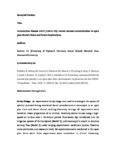COVID-19: dental aerosol contamination in open plan dental clinics and future implications
| dc.contributor.author | Ali, Kamran | |
| dc.contributor.author | Raja, M | |
| dc.date.accessioned | 2021-06-30T13:51:22Z | |
| dc.date.available | 2021-06-30T13:51:22Z | |
| dc.date.issued | 2021-06-25 | |
| dc.identifier.issn | 1462-0049 | |
| dc.identifier.issn | 1476-5446 | |
| dc.identifier.uri | http://hdl.handle.net/10026.1/17289 | |
| dc.description.abstract |
Study design An experimental study design was used to investigate the spread of splatter/aerosol during simulated dental procedures on a mannequin in open plan clinic and dental clinical teaching laboratory settings. All experiments were based on crown preparation of an artificial maxillary central incisor using a high-speed air turbine over a ten-minute period. Fluorescein dye was introduced into the irrigation system of the handpiece (model 1) and the mannequin's mouth was used to simulate salivary flow (model 2) under varying experimental conditions (suction flow rate, cross ventilation and exposure time). Six experiments were conducted in the open plan clinic while three experiments were undertaken in the clinical laboratory. Customised rigs with collection platforms consisting of filter papers were placed in open plan bays and adjacent walkways. Samples were also collected from a 400 cm2 area in each of the eight adjacent bays. Time course experiments repeated the same procedures on three occasions in a clinical laboratory and utilised a rig with eight four-metre rods supporting collection platforms around a dental mannequin. The distribution of fluorescein dye was analysed by fluoroscopy and spectrofluorometry.Results Contamination levels showed variations under different experimental conditions. In the absence of suction and cross ventilation, contamination was observed at large distances. Use of suction reduced contamination in the operating bay by 53% and 81.83%, while cross ventilation reduced contamination in adjacent and distant areas by 80-89%. Minimal contamination was detected at a distance of >5 m from the operating bay, with the use of medium-volume suction demonstrating that 1.5-metre-high partitions with open fronts limit 99.99% of splatter from aerosol generating procedures (AGPs) to the operating bay. Minimal additional aerosol contamination was detected ten minutes after the procedure.Conclusions Contamination from dental AGPS has the potential to contaminate distant sites in open plan clinics. Risk of cross infection is small if the bays are >5 m apart and contamination can be minimised with the use of suction and cross ventilation. | |
| dc.format.extent | 54-55 | |
| dc.format.medium | ||
| dc.language | en | |
| dc.language.iso | en | |
| dc.publisher | Springer Nature [academic journals on nature.com] | |
| dc.subject | Aerosols | |
| dc.subject | COVID-19 | |
| dc.subject | Dental Clinics | |
| dc.subject | Humans | |
| dc.subject | SARS-CoV-2 | |
| dc.subject | Suction | |
| dc.title | COVID-19: dental aerosol contamination in open plan dental clinics and future implications | |
| dc.type | journal-article | |
| dc.type | Journal Article | |
| dc.type | Comment | |
| plymouth.author-url | https://www.ncbi.nlm.nih.gov/pubmed/34172904 | |
| plymouth.issue | 2 | |
| plymouth.volume | 22 | |
| plymouth.publication-status | Published | |
| plymouth.journal | Evidence-Based Dentistry | |
| dc.identifier.doi | 10.1038/s41432-021-0168-0 | |
| plymouth.organisational-group | /Plymouth | |
| plymouth.organisational-group | /Plymouth/Faculty of Health | |
| plymouth.organisational-group | /Plymouth/Users by role | |
| dc.publisher.place | England | |
| dcterms.dateAccepted | 2021-02-16 | |
| dc.rights.embargodate | 2021-12-25 | |
| dc.identifier.eissn | 1476-5446 | |
| dc.rights.embargoperiod | Not known | |
| rioxxterms.versionofrecord | 10.1038/s41432-021-0168-0 | |
| rioxxterms.licenseref.uri | http://www.rioxx.net/licenses/all-rights-reserved | |
| rioxxterms.licenseref.startdate | 2021-06-25 | |
| rioxxterms.type | Journal Article/Review |


